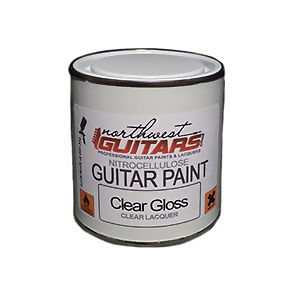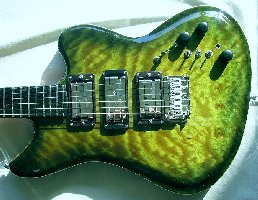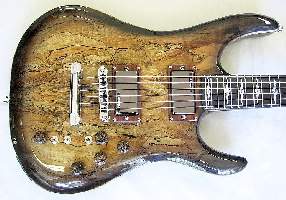Pros and Cons of Nitrocellulose Finish on Electric Guitars
Most options for wood finishing on guitars were originally used for general woodworking before being applied to electric guitars and acoustic electric guitars . The musical instrument enthusiasts know, though, that it takes more than just woodworking knowledge to make a good instrument-there's vibration and sound and a number of other factors to consider.

Nitrocellulose finish, also known as nitrocellulose lacquer has been the preferred method of finishing guitars in many countries, including the United States, for decades. More recently, however, the world of guitar making has seen better quality polyester, polyurethane, and other finishes that are beginning to rival this standard. So given the growing number of finishing options that are available to those interested in purchasing guitars, what are the advantages and disadvantages of nitrocellulose finish?
1. What Is a Nitrocellulose Finish?
Before looking at pros and cons, we should first define nitrocellulose finish, and how it compares to other finishing options. Nitrocellulose itself is a compound created by exposing cellulose to a nitrating agent such as nitric acid.
To create the lacquer, the nitrocellulose is combined with resins that have been dissolved in lacquer thinner solvent. This lacquer thinner is a volatile combination made of a variety of chemical solvents, and will dissolve when combined with the nitrocellulose a lacquer film. The lacquer can be applied with a brush, but works better when sprayed on to the surface.
The Finishing Process with Nitrocellulose Lacquer
- Sand all the surfaces and remove the sanding dust. Then cover the sound hole and the fingerboard
- Use 220 grit sandpaper on the hardwood surfaces and 320 grit sandpaper on softwood surfaces.
Use a vinyl sealer over the entire instrument. Then smooth out the rough surfaces with 320 grit sandpaper.
Use a pore filler to fill in the holes and wipe off the excess. Then use the vinyl sealer again and use it again. Finish by using the vinyl sealer a third time.
-
Making the lacquer finish
- Mix a thin lacquer solution and a thick lacquer solution.
- First apply several layers of thin lacquer, then several layers of thick lacquer. Sand the coating after every four layers of thick lacquer
- Mix a final thin lacquer solution by thinning the solution with lacquer retarder, and add four layers.
- Allow the lacquer to cure for 10 to 14 days for best results.
Sanding
- Wet sand the surface three times, using 600 grit, 1200 grit, and 2000 grit paper .
Hand-polish the surface to a high gloss using a cotton pad.

2. The Pros of a Nitrocellulose Finish
The advantages of using nitrocellulose finish are often related to what type of guitar you would like to use or make. It is often the case that an advantage for one kind of guitar is a disadvantage for another kind of guitar. For example, if you are looking to make a guitar for the commercial market, you should consider using nitrocellulose finish, since this is what is known to retailers. But there's a reason why nitrocellulose finish has been so popular for so long-it has many advantages when used on many different kinds of guitars, including electric guitars.
One feature of the lacquer thinner solvent used to create nitrocellulose finish is that it can dissolve already cured lacquer, including finishing that's already been applied to a guitar. This means it's easy to reapply a new coat of finish evenly across the surface of the guitar. Touch up and repair are relatively simple processes for nitrocellulose finishing, which is not the case for most other types of finishing.
Since nitrocellulose has so long been the standard for guitar finishing, it is well known by those working in instrument repair so fixing guitars with nitrocellulose finish this way is a tried and true process.
Nitrocellulose finish is durable, yet flexible, so that it will not easily crack when stressed; t therefore, it is well-suited for the expansion and contraction of wooden instruments. Because it's so thin, too, it does not impede the natural vibrations of the wood, the way older polyester finishes would.
The cured lacquer should be flat and glossy, but not on the same level as, say, glass; however, a series of wet sanding and hard polishing will bring the surface to an attractive high gloss. The lacquer works well with a number of dyes and pigments for customized coloring as well.


3. The Cons of a Nitrocellulose Finish
Several common misunderstandings about nitrocellulose finish can lead buyers to use it for the wrong kind of guitar, or incorrectly assume it will provide certain advantages. There are cons to this type of finish, though, in which case there may be a better finishing solution.
This issue only applies for those creating nitrocellulose lacquer and using it to finish a guitar. Exposure to lacquer thinner solvent during evaporation is a potential health risk. For safety, wear a vapor mask when working with the substance, and avoid contact with the skin and eyes. Be sure the room you are working in has good ventilation.
Nitrocellulose is also highly flammable. When not used in finish, it can even be used as a low-order explosive. For safety reasons, also, nitrocellulose lacquer products should not be used with acrylic lacquer products.
Nitrocellulose finish will, over time, lose its durability and crack. While it is durable and well known among guitar makers, it is not necessarily the best in terms of scratch resistance either. While it might not be as good at maintaining the natural vibration of the wood, thin polyurethane is more scratch resistant than nitrocellulose finish. The choice of finish is actually a very small factor in how a guitar sounds, especially on an electric guitar, so another option might be better.
4. Conclusion
If you are making a guitar or looking to purchase a guitar, nitrocellulose finish has a number of advantages, starting with the fact that it is widely used and well established among those who make guitars and those who repair them. It is at a disadvantage to other options in several ways, though, as it is less scratch resistant and potentially hazardous. Still, it's a good finish for electric guitars that produce a good tone and look nice to boot.
Valote
(collectibles: ebay)
Pictures are for illustration purposes only